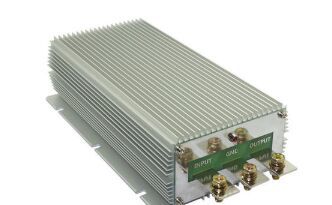Boost converters come in various shapes and sizes, and the supported power levels and boost ratios are very wide. These requirements determine whether the step-up voltage converter is most suitable for working in CCM or DCM. In DCM, the inductor current starts to rise from zero when the FET is turned on and is completely discharged to zero before the next switching cycle. But in the case of non-synchronous CCM boost, no matter whether the current is rising or falling, or the energy stored in the inductor is released to the output capacitor and load, the inductor current is always greater than zero.

In CCM, the duty cycle is constant for the load, but it changes with the input voltage(12v to 24v fixed converter for winch). In most CCM designs, when the load is lower than a certain minimum, the operating mode will switch to DCM, because the inductor current will eventually drop to zero before the next switching cycle.
In most cases, the high-power step-up voltage converter works in CCM, while the low-power boost is done in DCM. This is because CCM allows lower peak currents to flow through the entire circuit, which usually results in lower circuit losses. But there may be exceptions in output rectifiers for high-voltage boost conversion. For example, in PFC, reverse recovery current will cause more losses. This loss can usually be handled with high-quality (fast) rectifiers.
If working in DCM, there will be twice the peak inductor current in CCM mode, but if the inductance value is deliberately reduced, the current may be much higher. These higher currents not only increase the RMS current in the input and output capacitors but also increase the switching losses in the FET, so larger (or more) components are required to cope with the additional stress. This shortcoming alone usually masks the other advantages that DCM provides at high power.
Although the inductor RMS current is higher in DCM, its wire resistance is usually much lower, so the copper loss is often the same or lower than CCM. However, the core loss under DCM is greater at high power levels. Sometimes a larger core may be needed to handle these increased losses, which can overshadow the often exciting "smaller inductor size" advantage. The real advantage of DCM is in lower power levels, where the increased stress in capacitors and FETs does not necessarily require larger components, but smaller inductors.
An additional advantage of DCM is that when working at a high boost ratio (at this time, CCM operation requires a lot of on-time), the on-time can be shortened by reducing the inductance value (with higher peak current). This is very good, because the controller often reaches the maximum controllable on-time (or minimum off-time) limit, skipping pulses. In this way, the designer can fine-tune the turn-on and turn-off time according to the working range of the controller. In addition, the control loop performance of DCM is better than CCM, because there is no right half plane zero point, which can be converted into excellent transient performance.
Sometimes the influence of RHPZ can be minimized by reducing the inductance value, and we can push RHPZ to a higher frequency position with less influence. Whether under light load, start-up, or transient conditions, all CCM boosts can work in DCM under certain conditions.